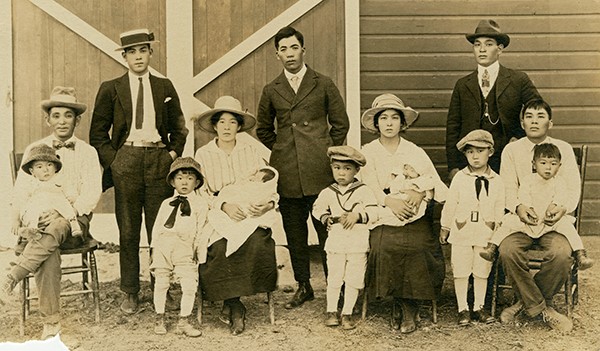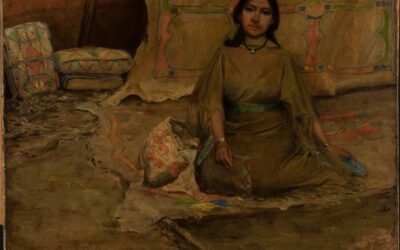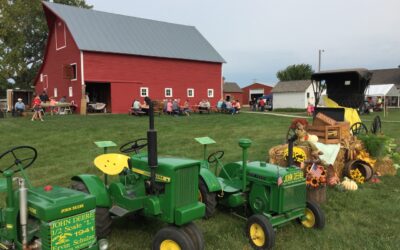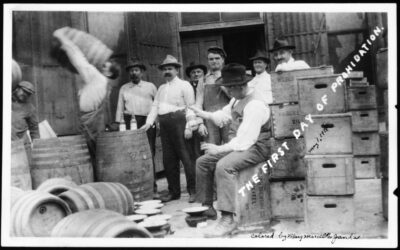By David L. Bristow, Editor
April 18, 2023
Japanese immigration to the West began following the Meiji Restoration of 1868, with immigrants coming first to Hawaiʻi and then to the West Coast.
Nebraska has been home to Japanese immigrants and their descendants since about 1900, with a little more than 800 Japanese immigrants living in the state (mostly in the Platte River Valley) by 1920. Members of Nebraska’s Japanese American community farmed, started businesses, participated in churches and cultural institutions, and served in the U.S. Armed Forces during World War II. More recently, their descendants have worked to preserve their community’s history.
This page provides links to articles and resources telling the stories of Nebraska’s Japanese American community.

Shiba and Sakurada families, Scottsbluff, Nebraska, 1923. History Nebraska RG5922-0-1
Nebraska Public Media’s Nebraska Stories provides an 11-minute video introduction to the topic in a 2016 episode titled “Invisible People.”
In 2022, Blake Ursch of Flatwater Free Press spoke to Vicki (Sakurada) Schaepler about efforts to preserve the Japanese Hall, a 1928 community center that now resides at the Legacy of the Plains Museum in Gering. Read “Japanese immigrants made Nebraska home. A granddaughter is ensuring we remember.”
History Nebraska has a collection of photos from one of western Nebraska’s Japanese families, the Sakuradas. View the photos here.
In 1921 the state legislature passed a law barring noncitizens from owning rural land or leasing it longer than five years. Because Japanese immigrants could not become U.S. citizens until 1952, the law effectively barred the “Issei” (first generation Japanese) from owning farms. Read more in “Japanese Immigration and Nebraska’s 1921 Alien Land Law” by Stephen W. Kay (Nebraska History Magazine, Winter 2022).
Nebraska’s Japanese remained a small percentage of the population and generally tried to avoid publicity. Richi Ugai of North Platte was an exception. The restaurateur and hotel owner became a locally prominent business owner in the early twentieth century, prospering even through World War II. Read “An Issei on the Plains: The Story of Richi Ugai” (PDF), by Griffen Farrar (Nebraska History Magazine, Winter 2015).

Ben Kuroki (Wikipedia)
Two months after Japan’s attack on Pearl Harbor on December 7, 1941, President Franklin Roosevelt signed Executive Order 9066, which resulted in the imprisonment of 75,000 Americans of Japanese ancestry and 45,000 Japanese nationals in prison camps across the country. The story of Japanese internment is told in the Smithsonian exhibition Righting a Wrong: Japanese Americans and World War II. (This exhibit will be at the Nebraska History Museum April 20-October 1, 2023.) The National Archives has more history, photos, and documents at “Japanese-American Incarceration During World War II.”
The internment order did not extend to the Japanese living in Nebraska, but the war with Japan affected their lives deeply. “The War: Nebraska Stories–Japanese Americans” at Nebraska Studies provides a brief introduction.
Ben Kuroki of Hershey, Nebraska, flew 58 combat missions on U.S. bombers in World War II, and was the only American of Japanese descent to serve in Army Air Forces combat operations in the Pacific. But before that, Kuroki “had to fight like hell for the right to fight for my own country.” An hour-long 2007 documentary film, Most Honorable Son, and supporting materials are available at PBS.
During the war, the University of Nebraska “was not only among the first to accept Japanese American students, but enrolled the second greatest number during the trying early years of 1942 and 1943.” Andrew Wertheimer argues that this controversial acceptance resulted from humanitarian decisions made by a few individuals. Read his article, “Admitting Nebraska’s Nisei: Japanese American Students at the University of Nebraska, 1942-1945,” (PDF) from the Summer 2002 issue of Nebraska History Magazine.
One of those university students, Joe Ishikawa, worked for the City of Lincoln recreation department after the war. But in 1946 he resigned in protest after learning that the municipal swimming pool did not allow Black people to enter. Ishikawa then worked with local Black leaders to pressure the city to open the pool to all. They succeeded.
Father Hiram Hisanori Kano (1889-1986) was a farmer, Episcopal priest, and community leader for many years. In 1984 he wrote A History of the Japanese in Nebraska (PDF via University of Nebraska at Kearney).

Sherman County farmer Hiram Hisanori Kano was president of the Japanese Americanization Society of Nebraska. This painting hangs in Bishop Beecher Memorial Hall in Mitchell, Nebraska. Photo courtesy of Holy Apostles’ Episcopal Church, Mitchell.




